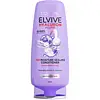What's inside
What's inside
 Key Ingredients
Key Ingredients

 Benefits
Benefits

 Concerns
Concerns

 Ingredients Side-by-side
Ingredients Side-by-side

Water
Skin ConditioningSodium Laureth Sulfate
CleansingCoco-Glucoside
CleansingGlycerin
HumectantDistearyl Ether
Skin ConditioningSodium Chloride
MaskingBehenyl Alcohol
EmollientCocamide Mipa
EmulsifyingLaureth-2
CleansingPPG-5-Ceteth-20
EmulsifyingSodium Benzoate
MaskingPolysilicone-8
Carbomer
Emulsion StabilisingArachidyl Alcohol
EmollientSodium Methylparaben
PreservativeSalicylic Acid
MaskingTaurine
BufferingStearyl Alcohol
EmollientAminomethyl Propanol
BufferingPolyquaternium-16
Hexyl Cinnamal
PerfumingLimonene
PerfumingLinalool
Perfuming2-Oleamido-1,3-Octadecanediol
Skin ConditioningHydroxycitronellal
PerfumingCitronellol
PerfumingBiotin
AntiseborrhoeicSodium Hydroxide
BufferingCitric Acid
BufferingParfum
MaskingWater, Sodium Laureth Sulfate, Coco-Glucoside, Glycerin, Distearyl Ether, Sodium Chloride, Behenyl Alcohol, Cocamide Mipa, Laureth-2, PPG-5-Ceteth-20, Sodium Benzoate, Polysilicone-8, Carbomer, Arachidyl Alcohol, Sodium Methylparaben, Salicylic Acid, Taurine, Stearyl Alcohol, Aminomethyl Propanol, Polyquaternium-16, Hexyl Cinnamal, Limonene, Linalool, 2-Oleamido-1,3-Octadecanediol, Hydroxycitronellal, Citronellol, Biotin, Sodium Hydroxide, Citric Acid, Parfum
Water
Skin ConditioningCetearyl Alcohol
EmollientDimethicone
EmollientGlycerin
HumectantBehentrimonium Chloride
PreservativeParfum
MaskingAmodimethicone
Phenoxyethanol
PreservativeCetrimonium Chloride
AntimicrobialIsopropyl Alcohol
SolventSodium Laureth Sulfate
CleansingLactic Acid
BufferingSodium Hyaluronate
HumectantSodium Hydroxide
BufferingLimonene
PerfumingCI 60730
Cosmetic ColorantCI 60725
Cosmetic Colorant
 Reviews
Reviews

Ingredients Explained
These ingredients are found in both products.
Ingredients higher up in an ingredient list are typically present in a larger amount.
Glycerin is already naturally found in your skin. It helps moisturize and protect your skin.
A study from 2016 found glycerin to be more effective as a humectant than AHAs and hyaluronic acid.
As a humectant, it helps the skin stay hydrated by pulling moisture to your skin. The low molecular weight of glycerin allows it to pull moisture into the deeper layers of your skin.
Hydrated skin improves your skin barrier; Your skin barrier helps protect against irritants and bacteria.
Glycerin has also been found to have antimicrobial and antiviral properties. Due to these properties, glycerin is often used in wound and burn treatments.
In cosmetics, glycerin is usually derived from plants such as soybean or palm. However, it can also be sourced from animals, such as tallow or animal fat.
This ingredient is organic, colorless, odorless, and non-toxic.
Glycerin is the name for this ingredient in American English. British English uses Glycerol/Glycerine.
Learn more about GlycerinLimonene is a fragrance that adds scent and taste to a formulation.
It's found in the peel oil of citrus fruits and other plants such as lavender and eucalyptus. The scent of limonene is generally described as "sweet citrus".
Limonene acts as an antioxidant, meaning it helps neutralize free radicals.
When exposed to air, oxidized limonene may sensitize the skin. Because of this, limonene is often avoided by people with sensitive skin.
The term 'fragrance' is not regulated in many countries. In many cases, it is up to the brand to define this term. For instance, many brands choose to label themselves as "fragrance-free" because they are not using synthetic fragrances. However, their products may still contain ingredients such as essential oils that are considered a fragrance.
Learn more about LimoneneParfum is a catch-all term for an ingredient or more that is used to give a scent to products.
Also called "fragrance", this ingredient can be a blend of hundreds of chemicals or plant oils. This means every product with "fragrance" or "parfum" in the ingredients list is a different mixture.
For instance, Habanolide is a proprietary trade name for a specific aroma chemical. When used as a fragrance ingredient in cosmetics, most aroma chemicals fall under the broad labeling category of “FRAGRANCE” or “PARFUM” according to EU and US regulations.
The term 'parfum' or 'fragrance' is not regulated in many countries. In many cases, it is up to the brand to define this term.
For instance, many brands choose to label themselves as "fragrance-free" because they are not using synthetic fragrances. However, their products may still contain ingredients such as essential oils that are considered a fragrance by INCI standards.
One example is Calendula flower extract. Calendula is an essential oil that still imparts a scent or 'fragrance'.
Depending on the blend, the ingredients in the mixture can cause allergies and sensitivities on the skin. Some ingredients that are known EU allergens include linalool and citronellol.
Parfum can also be used to mask or cover an unpleasant scent.
The bottom line is: not all fragrances/parfum/ingredients are created equally. If you are worried about fragrances, we recommend taking a closer look at an ingredient. And of course, we always recommend speaking with a professional.
Learn more about ParfumSodium Hydroxide is also known as lye or caustic soda. It is used to adjust the pH of products; many ingredients require a specific pH to be effective.
In small amounts, sodium hydroxide is considered safe to use. However, large amounts may cause chemical burns due to its high alkaline.
Your skin has a natural pH and acid mantle. This acid mantle helps prevent harmful bacteria from breaking through. The acid mantle also helps keep your skin hydrated.
"Alkaline" refers to a high pH level. A low pH level would be considered acidic.
Learn more about Sodium HydroxideSodium Laureth Sulfate (SLES) is a foaming, cleansing, and emulsifying ingredient. It is created from palm kernel oil or coconut oil. SLES is not the same as sodium lauryl sulfate. It is much milder and less likely to irritate.
SLES helps create foam in personal products. It also prevents ingredients from separating, helping to elongate the shelf life.
Sodium Laureth Sulfate is a type of sulfate. It can be drying. We recommend speaking with a professional about using this ingredient if you have concerns.
Learn more about Sodium Laureth SulfateWater. It's the most common cosmetic ingredient of all. You'll usually see it at the top of ingredient lists, meaning that it makes up the largest part of the product.
So why is it so popular? Water most often acts as a solvent - this means that it helps dissolve other ingredients into the formulation.
You'll also recognize water as that liquid we all need to stay alive. If you see this, drink a glass of water. Stay hydrated!
Learn more about Water